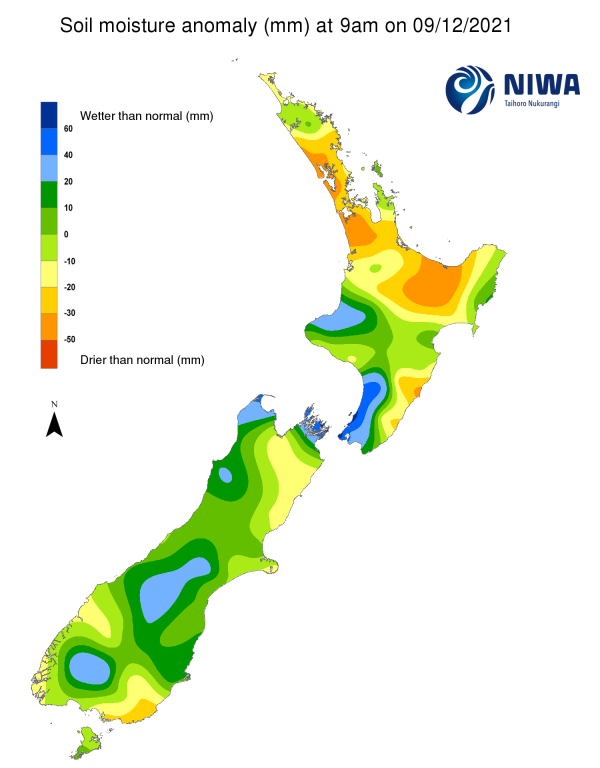A weekly update describing soil moisture patterns across the country to show where dry to extremely dry conditions are occurring or imminent. Regions experiencing significant soil moisture deficits are deemed “hotspots”. Persistent hotspot regions have the potential to develop into drought.
Facts: Soil Moisture
In the North Island, light rainfall was observed in the past week across Northland, Auckland, northern Waikato, Bay of Plenty, Gisborne, and northern Hawke’s Bay, where rainfall amounts were generally 10-15 mm or less. However, substantially higher amounts were observed in Taranaki, much of Manawatū-Whanganui, and western Wellington, where amounts of 50-100 mm were common, with some areas seeing more than 100 mm. This rainfall resulted in generally moderate to large soil moisture decreases across the northern half of the North Island, while the southern half generally saw moderate to large soil moisture increases. The driest soils across the North Island, when compared to normal for this time of the year, are found in parts of Northland, Auckland, northern Waikato, and eastern Bay of Plenty, while the wettest soils for this time of the year are found in southern Manawatū-Whanganui and western Wellington.
During the past week, the former hotspot located in Wairarapa dissipated, but new hotspots formed in southern Northland, northern Auckland, a small area near Whakatāne, and southern Hawke’s Bay. The New Zealand Drought Index (NZDI) map below shows that dry and very dry conditions are now located in Wairarapa as of 8 December.
In the South Island, heavy rainfall was observed across much of the West Coast and Tasman during the past week, with widespread amounts above 100 mm, and much of Westland receiving 200 mm or more. Parts of Southland and Otago received 30-50 mm, while the remainder of the eastern South Island generally received 15-30 mm. This resulted in moderate soil moisture increases for many areas, although increases were more modest in parts of Canterbury and eastern Marlborough. The driest soils in the South Island, when compared to normal for this time of the year, are located in coastal Southland, while the wettest soils for this time of the year are found near Farewell Spit and in Marlborough Sounds.
No hotspots are currently observed in the South Island. However, the New Zealand Drought Index (NZDI) map below shows that dry conditions are located from coastal Marlborough to central coastal Canterbury as of 8 December.
Outlook and Soil Moisture
In the North Island, rain may move across many areas on Sunday (12 December), bringing moderate amounts. By Tuesday and Wednesday, a plume of deep moisture associated with a tropical cyclone located in the Coral Sea is likely to bring periods of heavy rainfall to most locations. This heavy rain may result in areas of flooding during the middle of next week (14-15 December). Current forecasts indicate that the tropical cyclone itself may pass just to the northeast of New Zealand around Thursday or Friday next week, but this will need to be monitored in the coming days. Weekly rainfall amounts may be substantial across much of the North Island, with many areas approaching or exceeding 100 mm, and isolated amounts of 150 mm possible.
Due to the expected rainfall in the next week, soil moisture levels are likely to increase substantially across most, if not all, of the North Island. This would likely result in all current hotspots dissipating in the next week.
In the South Island, moderate rain will impact the West Coast on Saturday (11 December), with some rain crossing over into the eastern South Island as well. After a drier Sunday and Monday, the same tropical moisture plume mentioned above could impact the upper South Island with heavy rain on Tuesday and/or Wednesday. This may result in localised flooding as well. Generally drier weather is expected towards the end of next week. Weekly rainfall amounts of 50-100 mm may be widespread in the northern South Island, with localised higher amounts. Much lighter amounts are expected in Otago and Southland, which could receive 25 mm or less.
Due to the expected weekly rainfall, moderate to large soil moisture increases will be likely across the northern half of the South Island. Changes may be minimal farther south, although Southland may observe decreases in soil moisture levels. However, no new hotspots are expected to form.
Background:
Hotspot Watch: a weekly advisory service for New Zealand media. It provides soil moisture and precipitation measurements around the country to help assess whether extremely dry conditions are imminent.
Soil moisture deficit: the amount of water needed to bring the soil moisture content back to field capacity, which is the maximum amount of water the soil can hold.
Soil moisture anomaly: the difference between the historical normal soil moisture deficit (or surplus) for a given time of year and actual soil moisture deficits.
Definitions: “Extremely” and “severely” dry soils are based on a combination of the current soil moisture status and the difference from normal soil moisture (see soil moisture maps at https://www.niwa.co.nz/climate/nz-drought-monitor/droughtindicatormaps)
Hotspot: A hotspot is declared if soils are "severely drier than normal" which occurs when Soil Moisture Deficit (SMD) is less than -110 mm AND the Soil Moisture Anomaly is less than -20 mm.
Pictured above: Soil Moisture Anomaly Maps, relative to this time of year. The maps show soil moisture anomaly for the past two weeks.
New Zealand Drought Index (NZDI)
As of 8 December, the New Zealand Drought Index (NZDI) map below shows that dry conditions are now located in Wairarapa along with coastal areas from Marlborough to central Canterbury. In addition, very dry conditions are located in coastal Wairarapa. Please note: some hotspots in the text above may not correspond with the NZDI map. This difference exists because the NZDI uses additional dryness indices, including one which integrates the rainfall deficit over the past 60 days. Changes are therefore slower to appear in the NZDI compared to soil moisture anomaly maps that are instantaneously updated.




